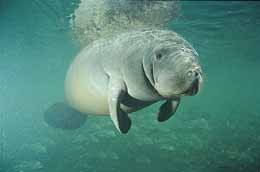by Editor | Jun 19, 2006 | Ecotourism, New Articles
By Patrick Rose, director, Government Relations, Save the Manatee Club
Patrick Rose, director, Government Relations, Save the manatee Club
Photo: Save the Manatee Club
Despite growing threats to the manatee’s long-term survival and overwhelming public opposition, the Florida Fish and Wildlife Commission (FWC) voted last week to prematurely downlist manatees from Endangered to Threatened. This decision plays right into the hands of those who want to exploit manatee habitat for development and high-speed recreation.
Even though the state found that the manatee population could be reduced by as much as 50 percent in the future and that manatees meet the federal and World Conservation Union’s (IUCN) definition for Endangered, manatees no longer qualify for state Endangered status because the FWC arbitrarily changed its listing/delisting rules by adopting the IUCN criteria for Endangered and then calling it Threatened.
Thirty conservation and animal welfare organizations representing millions of Americans around the nation urged FWC to fix its imperiled species classification system to properly align it with IUCN’s. Thirty-nine manatee and dugong scientists from numerous countries around the world sent a letter in opposition to the manatee’s downlisting. And people from all over the nation called the agency in protest, while hundreds more attended the Commission meeting. Out of scores of speakers at this meeting, only a handful of development, marine industries’ and go-fast boaters’ lobbyists spoke out in favor of downlisting manatees to Threatened!
Further, 17 organizations, filed a legal petition asking the FWC to fix its imperiled species classification system. But, in the end, none of it mattered to the Commissioners.
The FWC insists protections won’t change, but a review of Florida law shows Endangered species are afforded more protection than Threatened species. The Commission claims their Management Plan will protect manatees. However, Florida’s Legislature will be pressured to reduce FWC’s authority and funding to protect manatees. This will undermine the implementation of the Plan, and prevent real recovery.
The FWC and Governor Bush are declaring this a victory for manatees but the facts show otherwise. The agency claims that the manatee population is growing, yet a state report shows that only the 2 smallest subpopulations clearly show growth. Together, these 2 subpopulations only account for 16% of the manatee population. The largest subpopulation on the Atlantic coast shows a probable decline of about 3% per year over the last five years. The Southwest subpopulation is already in decline. Manatees continue to die from boat strikes in near-record numbers and there has been a 17% increase in manatee mortality from boat collisions over the last 5 year period as compared to the previous 5 year period!
Please ask yourself, can all of the organizations representing hundreds of thousands of Florida citizens and millions more people nationwide who have shared their concerns over the new listing process be wrong? I urge the Commission to take a step back from the situation and think about the repercussions to manatees and many other imperiled species if we are right and they are wrong. The consequences will be disastrous. If we are wrong and they are right, then no harm will have been done.
In the meantime manatees’ projected loss of winter habitat could cause catastrophic future losses. This is no time for celebration!
by Editor | Jun 17, 2006 | Luxury Travel

Minneapolis, MN (PRWEB) — A recent poll by Airlines.Ws of 1067 highly targeted airline passenger based readers revealed 67 percent thought cell phones should remain banned during flight. The remaining 33 percent said no. The polling lasted 45 days.
Cell phones are already banned during take offs and landings because of the possible risks associated with the radio interference of cell phones as well as other devices such as pagers, Palm Pilots, Blackberries, CD, MP3 players and laptops emitting RF signals.
“The risk posed by these portable devices is higher than previously believed. Radio frequency emitted from these devices can disrupt normal operation of key cockpit instruments, especially Global Positioning System (GPS) receivers, which are increasingly vital for safe landings,”, said Bill Strauss, one of the researchers of a February 2006 Carnegie Mellon University (CMU) study .
According to Airlines.Ws there is documentation which shows the possibility that cell phone interference resulted in the death of 10 passenger and crew members onboard a Crossair flight near Zurich, Switzerland in January 2000. Investigators found false readings given by aircraft instrumentation were later traced to the exact time of a text message received by a passenger.
The Radio Technical Commission for Aeronautics (RTCA) conducting PED studies since 1963, states cell phones “should be viewed as potentially hazardous and an unacceptable risk.” As of June 2005, “the FAA remains unconvinced that aircraft communication and navigation equipment can be adequately protected from onboard interference,” said Nicholas Sabatini, Associate Administrator for Aviation Safety, Federal Aviation Administration (FAA).
Before any change allowing cell phones in-flight the FAA and Federal Communication Commission (FCC) would need to lift their bans. The FCC has already voiced their opinion that they intend to lift their ban. The FAA is still studying the issue and doesn’t expect to have those results until the end of 2006.
While this polling was based on a safety issue, Airlines.Ws received more emails from respondents far more concerned over how disruptive cell phone conversations would be for themselves and other passengers than they were about any safety issue. Airlines.Ws is a directory of airlines, airline news, polls and commentary.
by Editor | Jun 12, 2006 | Accomodations, Luxury Travel, New Articles

Wild dogs at Eagles Crag at the Shamwari Game Reserve, South Africa
San Francisco, California – According to an Opinion Research Corporation national survey sponsored by the Adventure Collection, nearly 10 percent of respondents say they spend $5,000 or more on their adventure travel vacations. In addition, the survey found that 3 percent spent $9,000 or more. Among those with household incomes above $75,000, 17 percent said they spent $5,000 or more on their adventure travel vacations.
While age is not a factor in adventure travel, the Opinion Research survey confirmed that older travelers’ (65+) participation rate is significantly lower (32 percent), but they spend more money on their adventure vacation. And those adventure vacationers over age 35 spend significantly more than those under 35 years of age, although, 18-24 year olds have the highest participation in adventure travel activities at 53 percent.
The survey also found that of the geographic areas evaluated, the West (51 percent) has the highest level of participation in adventure travel followed by the Northeast at 48 percent, the North Central at 45 percent and the South at 41 percent.
“The findings on the adventure traveler were not surprising. It has been our experience, and the survey confirms, the higher one’s income and the more education one has, the more they spend on adventure travel,” said Ben Bressler, president of Adventure Collection member company Natural Habitat Adventures.
Formed in 2000, Adventure Collection comprises 11 independently owned active travel companies that came together through “a shared commitment to operating trips based on quality, experience, environmental responsibility and sustainable tourism.”
To read about ecotourism and adveture articles, visit our Botswana, Peruvian Amazon, http://simonandbaker.com/kruger, Shamwari and Zambia pages.
by Editor | Jun 5, 2006 | Ecotourism

West Indian manatee
Photo: Patrick M. Rose, Save the Manatee Club
West Indian manatees are protected in the United States under federal law by the Marine Mammal Protection Act of 1972 and the Endangered Species Act of 1973, which make it illegal to harass, hunt, capture, or kill any marine mammal. They are also protected by the Florida Manatee Sanctuary Act of 1978.
The Florida Fish & Wildlife Conservation Commission will vote on Wednesday, June 7, 2006 (at the West Palm Beach Marriott), on whether to downlist manatees and three other species. According to the Save the Manatee Club, conservation and animal welfare groups, and concerned citizens from Florida and around the nation urge the State to revise its imperiled species classification system to ensure numerous native species are not downlisted or delisted before their populations are recovered.
West Indian manatees are cute and rather large, gray aquatic mammals with round bodies that taper to a flat tail. They have two forelimbs called flippers and wrinkled head and face with whiskers on the snout. Related to the elephant and the hyrax, manatees are believed to have evolved from a wading, plant-eating animal. Manatees are harmless and slow-moving, dedicating their time to eating, resting, and migrating.
The average adult manatee is about 9.8 feet (three meters) long and weighs between 800-1,200 pounds (362-544 kilograms). A migratory herbivorous species they spend their time in shallow, calm rivers, estuaries, saltwater bays, canals and coastal areas. In the United States, West Indian manatees are most often in Florida in the winter, although in the summer they can be seen in Alabama, Georgia and South Carolina. They may also be found in Central America and along the northern coast of South America.
For information on manatees visit SaveTheManatee.org and for details on the upcoming Florida Fish & Wildlife Conservation Commission meeting online, go to MYFWC.com












